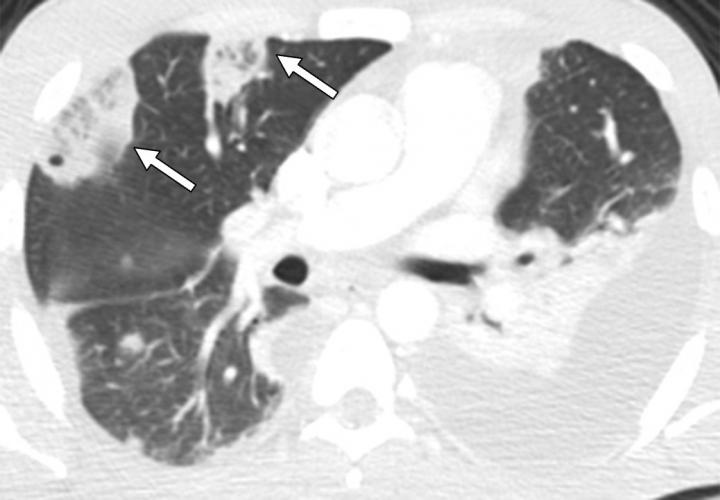American Journal of Roentgenology research finds that the reversed halo sign is an early and reliable imaging finding observed in most cases of CT-based diagnosis of septic pulmonary embolism secondary to intravenous substance use disorder

Credit: American Journal of Roentgenology (AJR)
Leesburg, VA, November 1, 2019–According to an article published ahead-of-print in the January 2020 issue of the American Journal of Roentgenology (AJR), the reversed halo sign was frequently observed on the chest CT scans of patients with IV substance use disorder-related septic pulmonary embolism (PE).
Of the 62 patients (54.8% women; 32.8 ± 8.3 [SD] years) who met Harvard Medical School radiologist Renata R. Almeida and colleagues’ inclusion criteria–IV substance use disorder, findings of septic PE on chest CT scans, and confirmation of infection–59.7% (37/62) had reversed halo signs (κ = 0.837-0.958, p
Moreover, the mean number of unique reversed halo signs per patient was 2.1 ± 1.7, with 46.7% of patients having more than one reversed halo sign.
Noting that the reversed halo sign was an early and reliable imaging finding observed in most cases of CT-based diagnosis of septic PE secondary to IV substance use disorder, as Almeida et al. concluded, “septic PE should be included in the differential diagnosis of patients presenting with the reversed halo sign and history of IV substance use disorder.”
The authors added: “Apparent differences of frequency, shape, and distribution in comparison with case series of pulmonary thromboembolism and invasive fungal infections could be investigated by future studies as possible biomarkers to assist in discrimination between septic PE and other causes of pulmonary infarct manifesting with the reversed halo sign.”
###
Founded in 1900, the American Roentgen Ray Society (ARRS) is the first and oldest radiology society in the North America, dedicated to the advancement of medicine through the profession of radiology and its allied sciences. An international forum for progress since the discovery of the x-ray, ARRS maintains its mission of improving health through a community committed to advancing knowledge and skills with an annual scientific meeting, monthly publication of the peer-reviewed American Journal of Roentgenology (AJR), quarterly issues of InPractice magazine, AJR Live Webinars and Podcasts, topical symposia, print and online educational materials, as well as awarding scholarships via The Roentgen Fund®.
Media Contact
Logan K. Young
[email protected]
703-858-4332
Original Source
https:/
Related Journal Article
http://dx.




